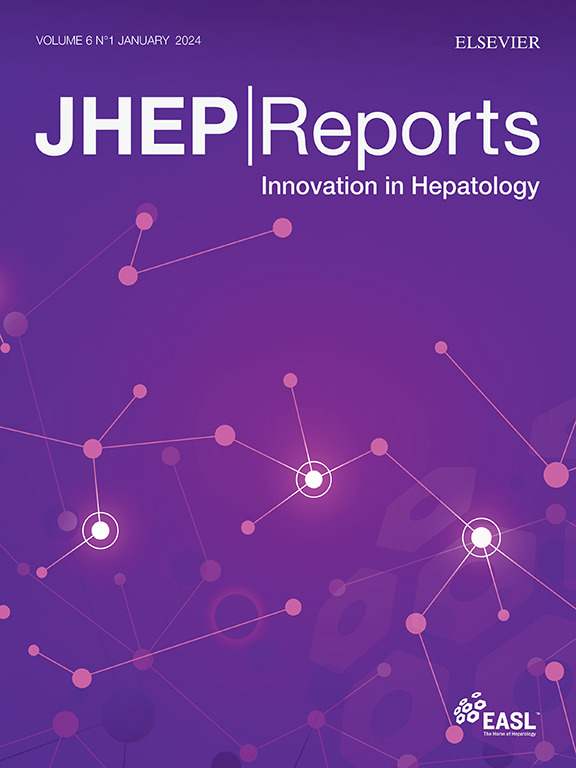MASLD患者的甲状腺功能障碍:一项全国性研究的结果
IF 9.5
1区 医学
Q1 GASTROENTEROLOGY & HEPATOLOGY
引用次数: 0
摘要
背景,甲状腺激素是肝脏代谢的有效调节剂,靶向甲状腺激素受体最近被批准为代谢相关脂肪变性肝病(MASLD)的第一种治疗方法;然而,甲状腺疾病与活检证实的MASLD之间的确切关系尚不清楚。方法:我们利用瑞典流行病学强化组织病理学报告(ESPRESSO)队列的数据进行了一项全国性匹配病例对照研究,其中包括1969年至2017年的肝活检数据。我们确定了12,172例MASLD患者和56,831例匹配的一般人群对照,包括5,478例MASLD患者和10,682例同胞对照。使用条件逻辑回归计算通过ICD代码或处方记录定义的甲状腺功能减退和甲状腺功能亢进的优势比。使用孟德尔随机化(MR)检验因果推断。通过观察和MR中介分析来探索代谢特征的作用。结果甲状腺功能减退与MASLD发生率增加1.68倍相关(95% CI 1.36-2.06)。在使用兄弟姐妹作为对照的分析中,这种关联保持稳定。然而,从绝对值来看,甲状腺功能减退并不常见,MASLD患者中有2.5%,对照组中有1.4%。较高的基因预测促甲状腺激素水平和甲状腺功能减退与MASLD风险增加有关。中介分析显示,代谢性疾病对这一风险的贡献率为41%。此外,甲亢和MASLD之间存在负相关(校正优势比0.17,95% CI 0.05-0.56);然而,在MR分析中,这种关联没有达到统计学意义。结论:甲状腺功能减退与MASLD的高风险相关,甲状腺功能亢进对MASLD有潜在的保护作用。影响和意义雷司替龙是一种甲状腺激素受体β选择性激动剂,用于治疗2-3期纤维化的非肝硬化代谢功能障碍相关脂肪性肝炎,这突出了甲状腺功能障碍在代谢相关脂肪性肝病(MASLD)中的潜在作用。本研究确定甲状腺功能减退是MASLD的一个危险因素,尤其是在男性和40岁以下的个体中,其相关性在非肝硬化纤维化时达到顶峰。代谢紊乱介导约41%的甲状腺功能减退- masld关联。甲亢与MASLD呈潜在负相关。尽管其患病率很低(MASLD病例为2.5%,对照组为1.4%),但甲状腺功能减退症对人群健康的影响值得进一步关注。本文章由计算机程序翻译,如有差异,请以英文原文为准。

Thyroid dysfunction in MASLD: Results of a nationwide study
Background & Aims
Thyroid hormones are known to be potent modulators of hepatic metabolism and targeting the thyroid hormone receptor was recently approved as the first treatment for metabolic-associated steatotic liver disease (MASLD); however, the exact relationship between thyroid disorders and biopsy-confirmed MASLD remains unclear.
Methods
We conducted a nationwide matched case–control study leveraging data from the Swedish Epidemiology Strengthened by histoPathology Reports in Sweden (ESPRESSO) cohort, which includes liver biopsy data spanning from 1969 to 2017. We identified 12,172 patients with MASLD and 56,831 matched general-population controls, including 5,478 patients with MASLD with 10,682 sibling controls. Conditional logistic regression was used to calculate odds ratios for hypothyroidism and hyperthyroidism defined through ICD codes or prescription records. Causal inference was examined using Mendelian randomization (MR). Both observational and MR mediation analyses were performed to explore the roles of metabolic features.
Results
Hypothyroidism was associated with 1.68-fold increased odds of MASLD (95% CI 1.36–2.06). The association remained stable in the analysis using siblings as controls. However, in absolute terms, hypothyroidism was uncommon and seen in 2.5% in people with MASLD and in 1.4% of controls. Higher genetically predicted thyroid-stimulating hormone levels and hypothyroidism were linked to increased MASLD risk. Mediation analysis showed that metabolic disorders contributed ∼41% to this risk. Furthermore, there was an inverse association between hyperthyroidism and MASLD (adjusted odds ratio 0.17, 95% CI 0.05–0.56); however, the association did not reach statistical significance in the MR analysis.
Conclusions
The findings suggest that hypothyroidism is associated with a heightened risk of MASLD and that hyperthyroidism is potentially protective against MASLD.
Impact and implications
The approval by the US FDA of resmetirom, a thyroid hormone receptor β-selective agonist for non-cirrhotic metabolic dysfunction-associated steatohepatitis with stage 2–3 fibrosis, highlights the potential role of thyroid dysfunction in metabolic-associated steatotic liver disease (MASLD). This study identified hypothyroidism as a risk factor for MASLD, especially in men and individuals younger than 40 years, with the association peaking at non-cirrhotic fibrosis. Metabolic disorders mediated ∼41% of the hypothyroidism–MASLD association. Hyperthyroidism was potentially inversely associated with MASLD. Despite its low prevalence (2.5% in MASLD cases, 1.4% in controls), the population health impact of hypothyroidism warrants further attention.
求助全文
通过发布文献求助,成功后即可免费获取论文全文。
去求助
来源期刊

JHEP Reports
GASTROENTEROLOGY & HEPATOLOGY-
CiteScore
12.40
自引率
2.40%
发文量
161
审稿时长
36 days
期刊介绍:
JHEP Reports is an open access journal that is affiliated with the European Association for the Study of the Liver (EASL). It serves as a companion journal to the highly respected Journal of Hepatology.
The primary objective of JHEP Reports is to publish original papers and reviews that contribute to the advancement of knowledge in the field of liver diseases. The journal covers a wide range of topics, including basic, translational, and clinical research. It also focuses on global issues in hepatology, with particular emphasis on areas such as clinical trials, novel diagnostics, precision medicine and therapeutics, cancer research, cellular and molecular studies, artificial intelligence, microbiome research, epidemiology, and cutting-edge technologies.
In summary, JHEP Reports is dedicated to promoting scientific discoveries and innovations in liver diseases through the publication of high-quality research papers and reviews covering various aspects of hepatology.
 求助内容:
求助内容: 应助结果提醒方式:
应助结果提醒方式:


